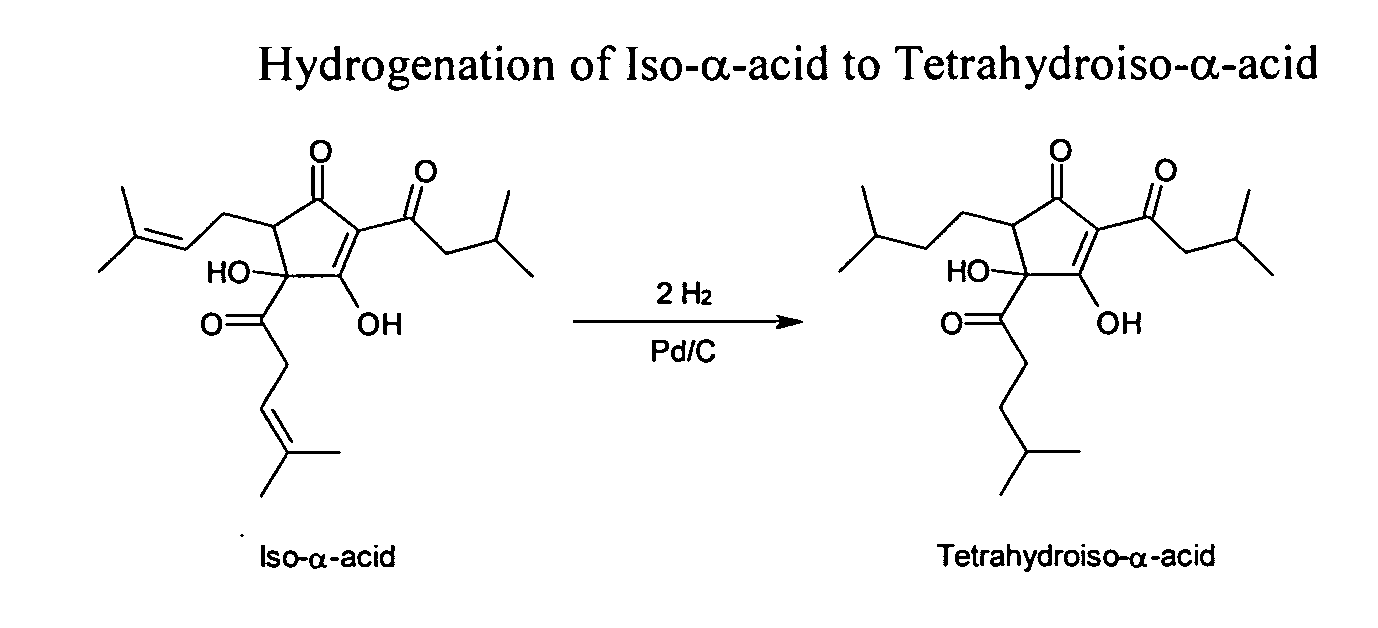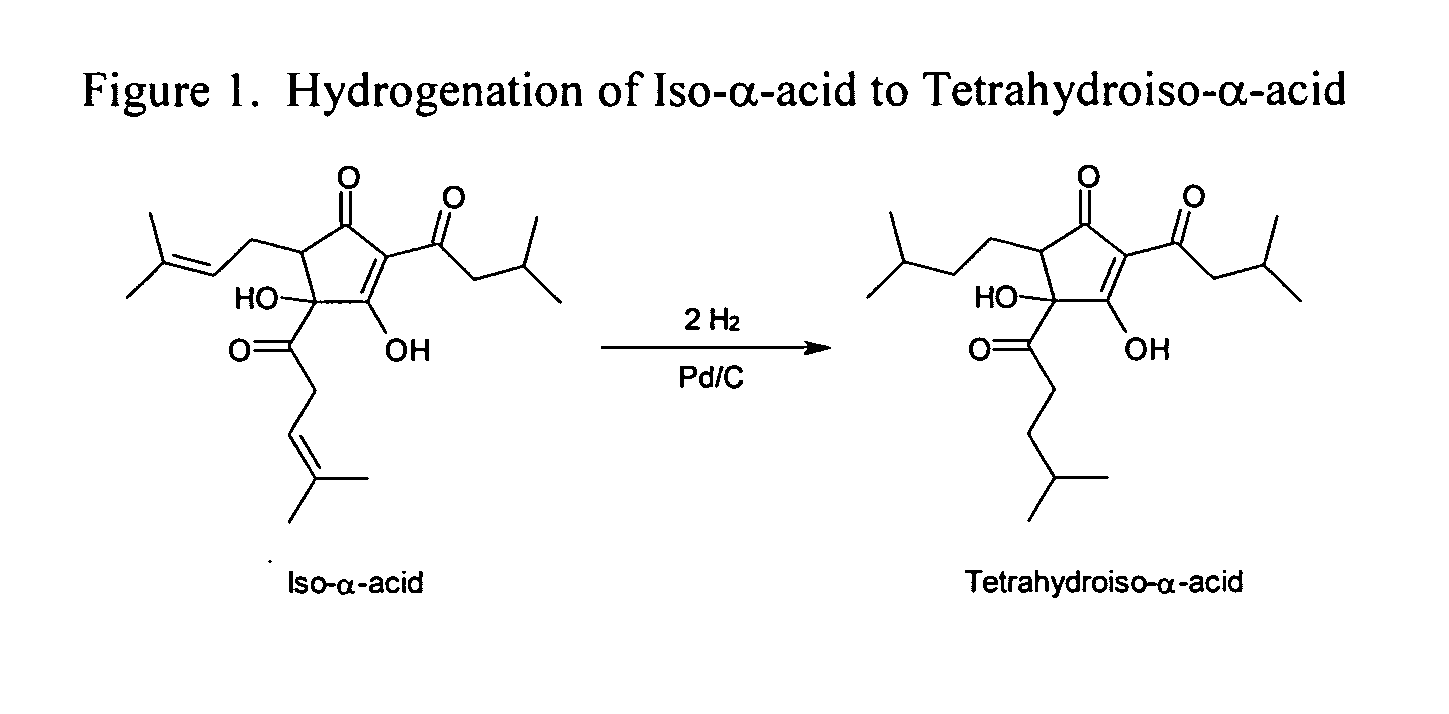Process for the preparation of tetrahydroisohumulone compositions
a technology of isohumulone and composition, which is applied in the preparation of carbonyl compounds, organic chemistry, alcoholic beverage preparation, etc., can solve the problems of degradation, and isohumulones are particularly unstabl
- Summary
- Abstract
- Description
- Claims
- Application Information
AI Technical Summary
Benefits of technology
Problems solved by technology
Method used
Image
Examples
example 1
Isolation of Humulones from CO2 Hop Extract and Isomerization
[0140]Supercritical CO2 hop extract (50.0 g), containing 51.4% humulones, was mixed with 1 volume of isohexane by overhead stirring in a 500-mL round bottom flask (RBF) until the extract dissolved. Aqueous 3% KOH solution (150. g) was added to the mixture to provide approximately 1.1 molar equivalents of KOH to humulones. The mixture was stirred for 20 minutes at 40° C., transferred to a 500-mL separatory funnel and allowed to separate for 30 minutes. The lower aqueous phase was collected and analyzed (results in Table 1 “Humulone Isolation” step). The pH of the humulone-enriched aqueous phase was adjusted from 8.6 to 9.0 with an aqueous 10% KOH solution and heated to reflux (˜104° C.) in a 500-mL RBF under an atmosphere of nitrogen. Once the solution approached reflux, 0.4 molar equivalents (relative to humulone) of an aqueous MgSO4 solution (7.12 g MgSO4 heptahydrate in 21 mL RO-grade water) was added slowly to the react...
example 2
Evaluation of Humulone Isolation Conditions from CO2 Hop Extract
[0142]The amount of humulones extracted from the hop extract was dependent on the molar equivalents of KOH added. Isohexane was added to dissolve the extract, assist in partitioning, and provide a cleaner cut of aqueous humulone to isomerize with minimal change to the valuable chemicals remaining in the hop extract, such as lupulones and hop oils. The humulones were separated from the hop extract by dissolving the hop extract with one volume of isohexane. The solution was mixed with a 3% KOH aqueous solution at 0.9-1.1 molar equivalent to humulone, which provided a pH of approximately 8.2-9.0. The solution was mixed for 10-20 minutes at 35-45° C. After stirring, the organic layer and humulone-enriched aqueous layers were separated. The separation step can be varied to obtain the highest yield of humulones with minimal lupulone and fatty acid concentrations based on the extract being used. A series of separations were pe...
example 3
Impact of the Amount of Mg(II) Ion on the Isomerization Process
[0144]The amount of isomerizing alkaline earth metal salt agent can impact reaction time and cis / trans-isomer levels of isohumulones. A series of reactions were performed using optimal aqueous humulone-enriched material from Example 2 to show the effects of various molar equivalents of MgSO4 on the resulting isohumulone product. Results of these experiments are shown in Table 3.
TABLE 3Experimental results for Example 3.Result after IsomerizationMg EquivalentsReactionResidualCis / TransID(mol)Time (hours)% HumuloneIsomer Ratio10.15.250.652.3220.21.50.393.0230.310.053.4340.40.750.083.8350.50.250.093.8861.00.043.94
[0145]It is important to minimize the amount of metal compositions being used so they can be effectively removed later in the process. The amount of MgSO4 used in this process was, but is not limited to, 0.4 molar equivalents relative to the amount of humulones in the reaction mixture. After reaction completion, the...
PUM
| Property | Measurement | Unit |
|---|---|---|
| Temperature | aaaaa | aaaaa |
| Temperature | aaaaa | aaaaa |
| Temperature | aaaaa | aaaaa |
Abstract
Description
Claims
Application Information
 Login to View More
Login to View More - R&D
- Intellectual Property
- Life Sciences
- Materials
- Tech Scout
- Unparalleled Data Quality
- Higher Quality Content
- 60% Fewer Hallucinations
Browse by: Latest US Patents, China's latest patents, Technical Efficacy Thesaurus, Application Domain, Technology Topic, Popular Technical Reports.
© 2025 PatSnap. All rights reserved.Legal|Privacy policy|Modern Slavery Act Transparency Statement|Sitemap|About US| Contact US: help@patsnap.com


